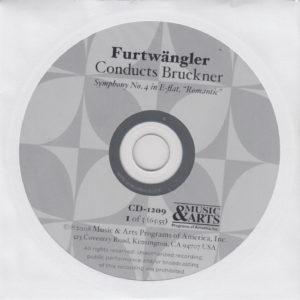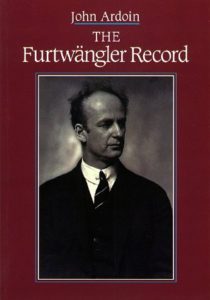 My “office” this morning is the second floor of the local library with a view that overlooks the field out back.
My “office” this morning is the second floor of the local library with a view that overlooks the field out back.
This is my favorite place to write.
The table height is perfect. The chairs are comfortable. The view is soothing. The environment is quiet, studious.
It’s the ideal place for…
 This morning, I’m listening to Anton Bruckner’s Symphony No. 4 in E Flat Major (WAB 104), nicknamed “Romantic,” interpreted by the legendary German conductor and composer Wilhelm Furtwangler (1886-1954).
This morning, I’m listening to Anton Bruckner’s Symphony No. 4 in E Flat Major (WAB 104), nicknamed “Romantic,” interpreted by the legendary German conductor and composer Wilhelm Furtwangler (1886-1954).
His orchestra is equally legendary, the Wiener Philharmoniker or – as it’s more commonly known – the Vienna Philharmonic.
From the entry about him on Wikipedia,
Wilhelm Furtwängler (January 25, 1886 – November 30, 1954) was a German conductor and composer. He is considered to be one of the greatest symphonic and operatic conductors of the 20th century.
Furtwängler was principal conductor of the Berlin Philharmonic between 1922 and 1945, and from 1952 until 1954. He was also principal conductor of the Gewandhaus Orchestra (1922–26), and was a guest conductor of other major orchestras including the Vienna Philharmonic.
He was the leading conductor to remain in Germany during the Second World War, although he was not an adherent of the Nazi regime. This decision caused lasting controversy, and the extent to which his presence lent prestige to the Third Reich is still debated.
Furtwängler’s conducting is well documented in commercial and broadcast recordings and has contributed to his lasting reputation. He had a major influence on many later conductors, and his name is often mentioned when discussing their interpretive styles.
Of Furtwangler’s style of conducting, the entry on Wikipedia reads,
Conducting style
Furtwängler had a unique philosophy of music. He saw symphonic music as creations of nature that could only be realised subjectively into sound. Neville Cardus wrote in the Manchester Guardian in 1954 of Furtwängler’s conducting style:
He did not regard the printed notes of the score as a final statement, but rather as so many symbols of an imaginative conception, ever changing and always to be felt and realised subjectively…Not since Nikisch, of whom he was a disciple, has a greater personal interpreter of orchestral and opera music than Furtwängler been heard.
And the conductor Henry Lewis:
I admire Furtwängler for his originality and honesty. He liberated himself from slavery to the score; he realized that notes printed in the score, are nothing but SYMBOLS. The score is neither the essence nor the spirit of the music. Furtwängler had this very rare and great gift of going beyond the printed score and showing what music really was.
Many commentators and critics regard him as the greatest conductor in history. In his book on the symphonies of Johannes Brahms, musicologist Walter Frisch writes that Furtwängler’s recordings show him to be “the finest Brahms conductor of his generation, perhaps of all time”, demonstrating “at once a greater attention to detail and to Brahms’ markings than his contemporaries and at the same time a larger sense of rhythmic-temporal flow that is never deflected by the individual nuances. He has an ability not only to respect, but to make musical sense of, dynamic markings and the indications of crescendo and diminuendo[…]. What comes through amply… is the rare combination of a conductor who understands both sound and structure.” He notes Vladimir Ashkenazy who says that his sound “is never rough. It’s very weighty but at the same time is never heavy. In his fortissimo you always feel every voice…. I have never heard so beautiful a fortissimo in an orchestra”, and Daniel Barenboim says he “had a subtlety of tone color that was extremely rare. His sound was always ’rounded,’ and incomparably more interesting than that of the great German conductors of his generation.”
A little background on the Vienna Philharmonic, according to its entry on Wikipedia, is in order here:
The Vienna Philharmonic (VPO; German: Wiener Philharmoniker), founded in 1842, is an orchestra regularly considered one of the finest in the world.
The Vienna Philharmonic is based at the Musikverein in Vienna, Austria. Its members are selected from the orchestra of the Vienna State Opera. Selection involves a lengthy process, with each musician having to demonstrate his or her capability for a minimum of three years’ performing for the opera and ballet. After this probationary period, the musician may request from the Vienna Philharmonic’s board an application for a position in the orchestra.
In 2006, the Vienna Philharmonic was chosen as Europe’s finest orchestra in a survey of seven leading trade publications, two radio stations and a daily newspaper. In 2008, an international jury of music critics polled by the British Gramophone magazine ranked it third in the world (after the Royal Concertgebouw Orchestra and Berlin Philharmonic).
Subscription ticket demand for the Vienna Philharmonic at their home, Musikverein, is currently listed on the orchestra’s website as being subject to a waiting list—six years for weekday concert subscriptions, and thirteen years for weekend subscriptions. Casual tickets however, are available in small numbers and can be bought via links from the official website, to various ticket resellers. It is also possible to book package deals which include transport, hotel accommodation, meals and tickets to concerts
Given the historical nature of this performance (it was recorded 66 years ago), and despite the fame of Furtwangler and the Vienna Orchestra, I don’t expect to hear something akin to what’s found in the Marek Janowski box set released by Pentatone. This won’t be an eargasm. More than likely, this will sound like two tin cans and a string with a third string leading to a reel-to-reel tape machine.
I’m prepared for that.
But you know how this works.
First, the objective stuff.
Then, my opinion of the performance and box set and liner notes, etc.
The objective stuff:
 Bruckner’s Symphony No. 4 in E Flat Major (WAB 104), composed 1873-1874
Bruckner’s Symphony No. 4 in E Flat Major (WAB 104), composed 1873-1874
Wilhelm Furtwangler conducts
Furtwangler used the “1888 Gutman Edition,” according to the liner notes.
Wiener Philharmoniker (Vienna Philharmonic) plays
The symphony clocks in at 65:55
This was recorded in Stuttgart, Germany, on October 22, 1951
Furtwangler 65 was when he conducted it (he would die of pneumonia just three years later)
Bruckner was 50 when he finished composing it (the first time)
This recording was released on the Music & Arts Programs of America label
From the liner notes, written by John Ardoin,
Furtwangler often spoke of Bruckner in the same affectionate terms he reserved for Beethoven and Brahms, and he found Bruckner’s music “timeless.” To him Bruckner’s strength was his ability to soar “broadly and freely in a state of bliss, released from earthly cares – fulfillment without sentimentality, without calculation.” While Furtwangler did see Bruckner as a part of his age, he also realized that he stood apart from it. “H did not strive to achieve immediate success. His art was not for time but for eternity, so it was for eternity he worked. Thus he became the most misunderstood of musicians.”
Bruckner wrote his symphonies in four movements. The time breakdown of this one (Symphony No. 4 in E Flat Major), from this particular conductor (Furtwangler) and this particular orchestra (Wiener Philharmoniker) is as follows:
I. Bewegt, nicht zu schnell……………………………………………………………………17:38
II. Andante, quasi allegretto…………………………………………………………………18:10
III. Scherzo. Bewegt (With motion) – Trio: Nicht zu schnell (Not too fast)……………………………………………………………………………………………………….10:28
IV. Finale: Bewegt, doch nicht zu schnell (With motion, but not too fast)……………………………………………………………………………………………………….19:21
Total running time: 65:55
Okay. Now, here are the subjective aspects:
 My Rating:
My Rating:
Recording quality: 3
Overall musicianship: 4
CD liner notes: 4 (thin booklet – in English only – that’s an excerpt from John Ardoin’s book The Furtwangler Record published in 1994)
How does this make me feel: 4
On one hand, this recording is better than I thought it would be. It wasn’t quite two tin cans and a string recording into a reel-to-reel tape machine. It was actually quite decent, given the circumstances. The Music & Arts label (which bills itself as “An Independent Classical and Jazz Label”) did a fine job remastering this.
Yet, because of the age and technological challenges of this recording, my favorite parts (the French horn opening of the first movement, for example) are buried in the mix. So my ability to enjoy what’s going on is diminished from the outset.
Still, what I’m hearing has an unmistakable greatness to it.
And an almost eeriness, frankly.
I’m hearing people shuffle and cough and adjust their seats, music stands…
And I know it’s almost a certainty that they’re all dead.
I’m listening to something akin to a time capsule, a recording from an age so far removed from our own that the historicity of it probably overshadows its actual value.
Wilhelm Furtwangler was born 10 years before Bruckner died. That makes him, in all likelihood, the only conductor I’ll ever listen to who was alive when Bruckner was alive.
That boggles my mind.
Was little Wilhelm aware of Anton Bruckner’s music? I’ll have to read a bio of Furtwangler to find out.
But this overlap in Bruckner’s life with Furtwangler’s adds (at least, to me) gravitas to Maestro Furtwangler’s importance in the music world, as well as his interpretations of Bruckner’s symphonies.
Given the age of the recordings, however, it’s possible we’ll never be able to compare apples to apples – Furtwangler to, say, Barenboim. The sounds are so different. The modern-day recordings sound so much better…even though they may not be as good, musically speaking. Still, the scales will have been tipped.
Despite that, there’s something here. Even I can hear that. And I’m pretty dense when it comes to musicology.
The lack of volume on the horns in the opening movement is somewhat redeemed by a lively Scherzo that features horns to nice effect, giving it the English hunt feel the movement requires.
Overall, this is a fascinating recording. I’m positive I wouldn’t immediately suggest this to a Bruckner noob as an introduction to his Fourth.
But, as an essential piece of music history, sure. This is a must-hear performance.
